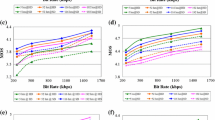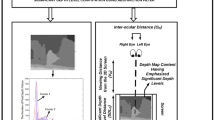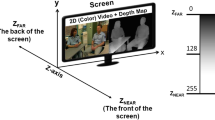Abstract
For enjoying 3D video to its full extent, it is imperative that access and consumption of it is user centric, which in turn ensures improved 3D video perception. Several important factors including video characteristics, users’ preferences, contexts prevailing in various usage environments, etc have influences on 3D video perception. Thus, to assist efficient provision of user centric media, user perception of 3D video should be modeled considering the factors affecting perception. Considering ambient illumination context to model 3D video perception is an interesting research topic, which has not been particularly investigated in literature. This context is taken into account while modeling video quality and depth perception of 3D video in this paper. For the video quality perception model: motion and structural feature characteristics of color texture sequences; and for the depth perception model: luminance contrast of color texture and depth intensity of depth map sequences of 3D video are used as primary content related factors in the paper. Results derived using the video quality and depth perception models demonstrate that these models can efficiently predict user perception of 3D video considering the ambient illumination context in user centric media access and consumption environments.




Similar content being viewed by others
References
Canny JF (1986) A computational approach to edge detection. IEEE Trans Pattern Anal Mach Intell 8(6):679–698
Devore JL (1995) Probability and statistics for engineering and the sciences. Duxbury
DJ Fleet, Y Wiess (2006) Optical flow estimation in Paragios. Handbook of Math. Models in Comp. Vis., Springer
Frazor RA, Geisler WS (2006) Local luminance and contrast in natural images. Elsevier Vis Res Journ 59(46):1585–1598
Geisler WS (2008) Visual perception and the statistical properties of natural scenes. Annu Rev Psychol 26(59):167–192
Ghanbari M (2003) Standard codecs: image compression to advanced video coding. The Institution of Electrical Engineers, London
Girod B (1993)What’s wrong with mean-squared error. Digital Images and Human Vision, A. B. Watson Ed., Chapter 15, the MIT press, pp 207–220
Gretag Macbeth Eye-One Display 2, http://www.xrite.com
Grigorescu C, Petkov N, Westenberg MA (2004) Contour and boundary detection improved by surround suppression of texture edges. Image Vis Comput 22(8):609–622
Hall P, Wand MP (1988) On the minimization of absolute distance in kernel density estimation. Stat Probab Lett 6:311–314
Hewage CTER, Worrall ST, Dogan S, Villette S, Kondoz AM (2009) Quality evaluation of color plus depth map based stereoscopic video. IEEE J Selected Top Signal Process Vis Media Qual Assess 3(2):304–318
http://www.mathworks.com/access/helpdesk/help/toolbox/curvefit/
Huynh-Thu Q, Ghanbari M (2008) Scope of validity of PSNR in image/video quality assessment. IET Electron Lett 44(13):800–801
Ichihara S, Kitagawa N, Akutsu H (2007) Contrast and depth perception: effects of texture contrast and area contrast. Perception 36(5):686–695
International Telecommunication Union (ITU) (2002) Radio Communication Sector: ‘Methodology for the Subjective Assessment of the Quality of Television Pictures’, ITU-R BT.500-11
Jones V (2009) Mean direction and mean absolute deviation. ASTM Standards and Engineering Digital Library
JSVM 9.13.1, CVS Server, garcon.ient.rwth-aachen.de/cvs/jv
Malik J, Belongie S, Leung T, Shi J (2001) Contour and texture analysis for image segmentation. Int Journ Comput Vis 1(43):7–27
Nur G, Dogan S, Kodikara Arachchi H, Kondoz AM (2010) “Assessing the Effects of Ambient Illumination Change in Usage Environment on 3D Video Perception for User Centric Media Access and Consumption,” 2nd International ICST Conference on User Centric Media, Palma de Mallorca, Spain
G Nur, S Dogan, H Kodikara Arachchi, AM Kondoz (2010) Impact of Depth Map Spatial Resolution on 3D Video Quality and Depth Perception. IEEE 3DTV Conference: The True Vision—Capture, Transmission and Display of 3D Video, Tampere, Finland
Papari G, Campisi P, Petkov N, Neri A (2006) A Multiscale Approach to Contour Detection by Texture Suppression. SPIE Im.Proc.: Alg. and Syst., vol. 6064A, pp. 107–118, San Jose, CA, USA
Robinson TR (1896) Light Intensity and Depth Perception. Am J Psychol 7(4):518–532
Shi J, Tomasi C (1994) Good features to track. IEEE Conf. on Com. Vis. and Pat. Recog, Seattle
A Tikanmaki, A Gotchev, A Smolic, K Miller (2008) Quality Assessment of 3D Video in Rate Allocation Experiments. IEEE Symposium on Consumer Electronics
Wang Z, Lu L, Bovik AC (2004) Video quality assessment based on structural distortion measurement. Proc Signal Process Image Commun 19(2):121–132
Wolf S, Pinson M (2002) VQM Software and Measurement Techniques. National Telecommunications and Information Administration Report 02–392
Acknowledgement
This work has been supported in part by the MUSCADE Integrating Project (http://www.muscade.eu) funded under the European Commission ICT 7th Framework Programme.
Author information
Authors and Affiliations
Corresponding author
Rights and permissions
About this article
Cite this article
Nur, G., Arachchi, H.K., Dogan, S. et al. Modeling user perception of 3D video based on ambient illumination context for enhanced user centric media access and consumption. Multimed Tools Appl 70, 333–359 (2014). https://doi.org/10.1007/s11042-011-0824-z
Published:
Issue Date:
DOI: https://doi.org/10.1007/s11042-011-0824-z




